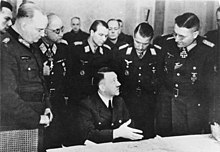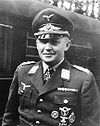
The Battle of Berlin, designated as the Berlin Strategic Offensive Operation by the Soviet Union, and also known as the Fall of Berlin, was one of the last major offensives of the European theatre of World War II.
Army Group Centre was the name of two distinct strategic German Army Groups that fought on the Eastern Front in World War II. The first Army Group Centre was created during the planning of Operation Barbarossa, Germany's invasion of the Soviet Union, as one of the three German Army formations assigned to the invasion.

Walther Wenck was a German officer and industrialist. He was the youngest General of the branch in the German Army and a staff officer during World War II. At the end of the war, he commanded the German Twelfth Army that took part in the Battle of Berlin. Wenck left the military after surrendering to the Allies. He was asked to become Inspector General of the Bundeswehr as West Germany was re-arming in 1957, but declined to take the post when conditions he set were not met, such as the Inspector General being the commander-in-chief of the armed forces, not just an administrative leader.

Felix Martin Julius Steiner was a German SS commander during the Nazi era. During World War II, he served in the Waffen-SS, the combat branch of the SS, and commanded several SS divisions and corps. He was awarded the Knight's Cross of the Iron Cross with Oak Leaves and Swords. Together with Paul Hausser, he contributed significantly to the development and transformation of the Waffen-SS into a combat force made up of volunteers and conscripts from both occupied and un-occupied lands.

Helmuth Otto Ludwig Weidling was a German general during the Second World War. He was the last commander of the Berlin Defence Area during the Battle of Berlin, led the defence of the city against Soviet forces and finally surrendered just before the end of World War II in Europe.

The 9th Army was a World War II field army. It was activated on 15 May 1940 with General Johannes Blaskowitz in command.

Gotthard Fedor August Heinrici was a German general during World War II. Heinrici is considered to have been the premier defensive expert of the Wehrmacht. His final command was Army Group Vistula, formed from the remnants of Army Group A and Army Group Center to defend Berlin from the Soviet armies advancing from the Vistula River.

The Vistula–Oder offensive was a Red Army operation on the Eastern Front in the European theatre of World War II in January 1945. The army made a major advance into German-held territory, capturing Kraków, Warsaw and Poznań. The Red Army had built up their strength around a number of key bridgeheads, with two fronts commanded by Marshal Georgy Zhukov and Marshal Ivan Konev. Against them, the German Army Group A, led by Colonel-General Josef Harpe, was outnumbered five to one. Within days, German commandants evacuated the concentration camps, sending the prisoners on their death marches to the west, where ethnic Germans also started fleeing. In a little over two weeks, the Red Army had advanced 480 kilometres (300 mi) from the Vistula to the Oder, only 69 kilometres (43 mi) from Berlin, which was undefended. However, Zhukov called a halt, owing to continued German resistance on his northern flank (Pomerania), and the advance on Berlin had to be delayed until April.

The 4th Panzer Army, operating as Panzer Group 4 from its formation on 15 February 1941 to 1 January 1942, was a German panzer formation during World War II. As a key armoured component of the Wehrmacht, the army took part in the crucial battles of the German-Soviet war of 1941–45, including Operation Barbarossa, the Battle of Moscow, the Battle of Stalingrad, the Battle of Kursk, and the 1943 Battle of Kiev.

The Battle of the Oder–Neisse is the German name for the initial (operational) phase of one of the last two strategic offensives conducted by the Red Army in the Campaign in Central Europe during World War II. Its initial breakthrough phase was fought over four days, from 16 April until 19 April 1945, within the larger context of the Battle of Berlin. The Soviet military planners divide the frontal and pincer phases of the operation, named Berlin Strategic Offensive Operation into:

The East Prussian offensive was a strategic offensive by the Soviet Red Army against the German Wehrmacht on the Eastern Front. It lasted from 13 January to 25 April 1945, though some German units did not surrender until 9 May. The Battle of Königsberg was a major part of the offensive, which ended in victory for the Red Army.
The 3rd Panzer Army was a German armoured formation during World War II, formed from the 3rd Panzer Group on 1 January 1942.

The 11th SS Panzer Army was little more than a paper army formed in February 1945 by Heinrich Himmler while he was commander of Army Group Vistula.
Army Detachment Steiner, also referred to as Army Group Steiner or Group Steiner, was a temporary military unit (Armeegruppe-type), mid-way in strength between a corps and an army, created on paper by Adolf Hitler on 21 April 1945 during the Battle of Berlin, and placed under the command of SS-Obergruppenführer Felix Steiner.

The East Pomeranian strategic offensive operation was an offensive by the Soviet Red Army against the German Wehrmacht on the Eastern Front. It took place in Pomerania and West Prussia from 10 February – 4 April 1945.

Kurt Oskar Heinrich Ludwig Wilhelm von Tippelskirch was a general in the Wehrmacht of Nazi Germany during World War II who commanded several armies and Army Group Vistula. He surrendered to the United States Army on 2 May 1945. Tippelskirch wrote several books, such as the History of the Second World War, 1951. He died in 1957.
Operation Solstice, also known as Unternehmen Husarenritt or the Stargard tank battle, was one of the last German armoured offensive operations on the Eastern Front in World War II.

The Upper Silesian offensive was a strategically significant Soviet offensive on the Eastern Front of World War II in 1945. It was aimed at capturing the considerable industrial and natural resources located in Upper Silesia and involved forces of the 1st Ukrainian Front under Marshal Ivan Konev. Due to the importance of the region to the Germans, considerable forces were provided to Army Group Centre for its defence and the Germans were only slowly pushed back to the Czech border. Fighting for the region lasted from mid January right until the last day of the war in Europe on May 8, 1945.
The XXIV Army Corps was a unit of the German Army during World War II. The unit was re-designated several times; originally being Generalkommando der Grenztruppen Saarpfalz, later Generalkommando XXIV. Armeekorps, then XXIV. Armeekorps (mot.) and finally XXIV. Panzerkorps.
The CI Army Corps, alternatively also referred to as Roman 101st Corps, was a corps-level unit of the German Wehrmacht during World War II. It existed only for a few months during the year 1945.


















